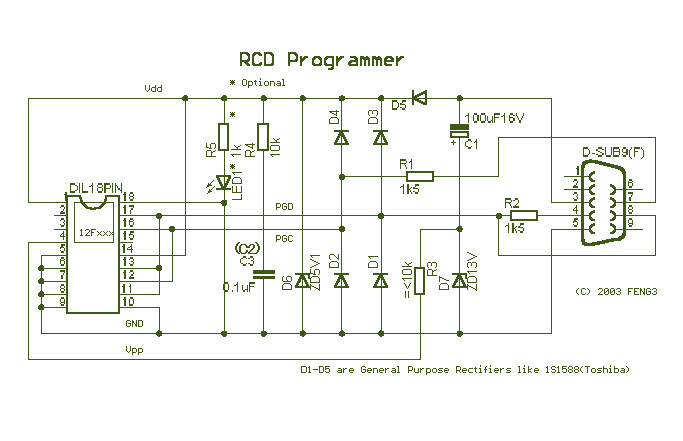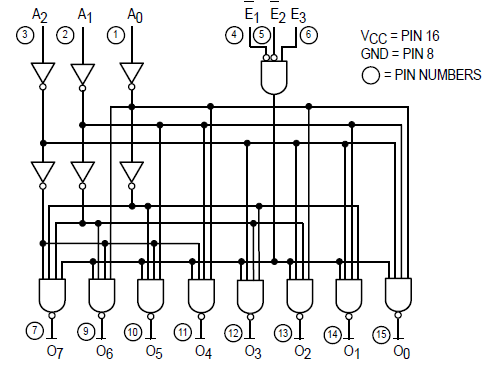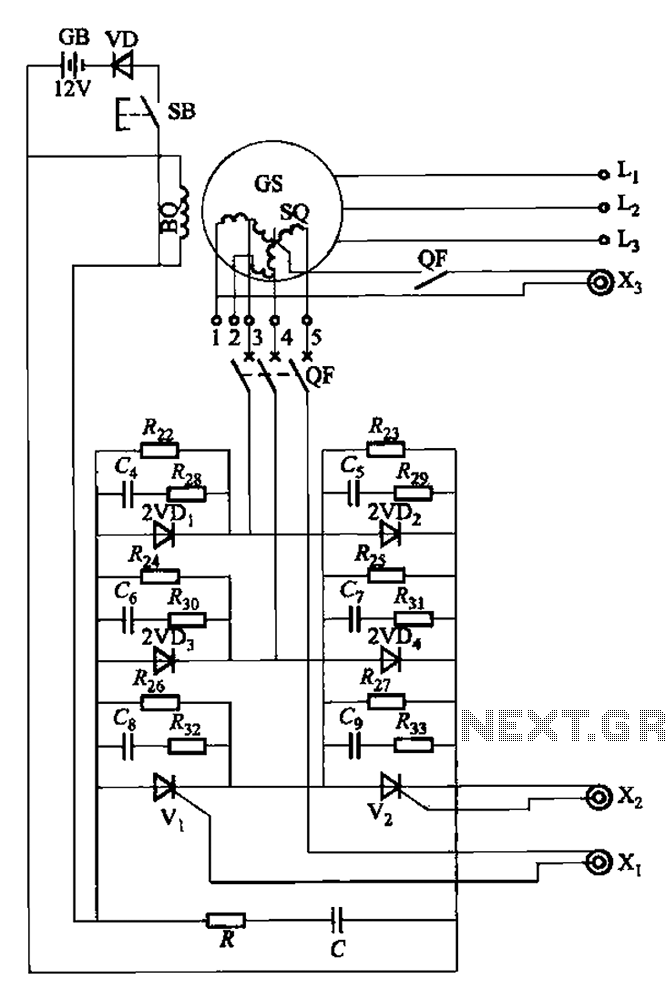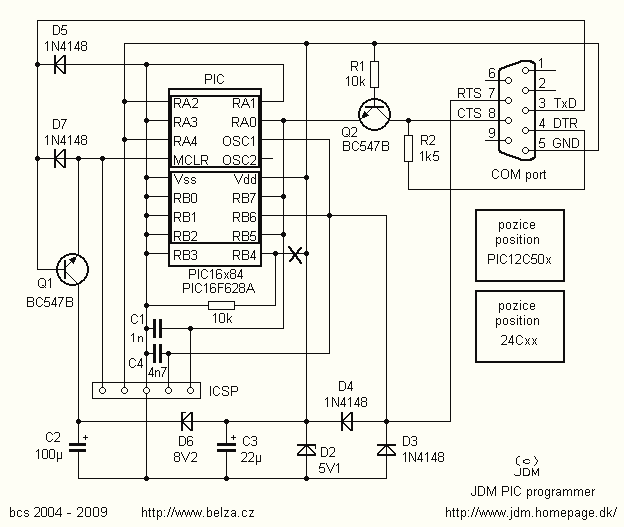
Extensible Multiple Device Programmer 3
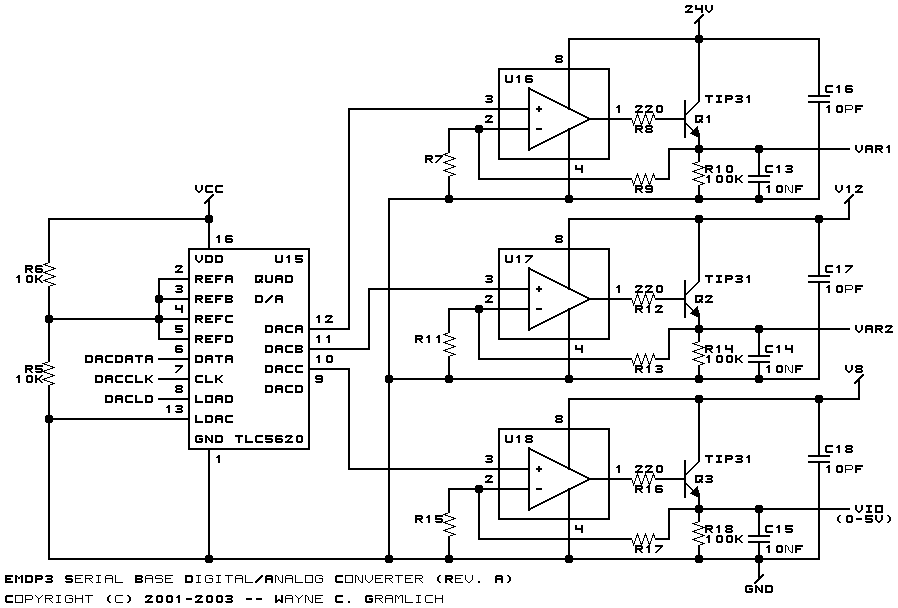
The power supply utilizes an Underwriters Laboratory® approved "wall wart" to deliver 24VDC of power, ensuring that the base board does not have any 110V AC or similar voltages present. Power can be supplied through either N1 (on-board) or N3 (off-board). The power switch is located either on-board at SW1 or off-board as SW2 through connector N2. A resettable polyswitch fuse (F1) is incorporated to manage short circuits, while D1 acts as a shorting diode that will trigger F1 if an AC power source is mistakenly connected to N1 or N3. The power supply consists of a series of low-cost linear voltage regulators (VR1-VR5) that step down the voltage from 24V to 18V, 12V, 8V, and finally to 5V. All these supplies are utilized elsewhere on the board, except for the 18V output, which is used to prevent excessive heat dissipation in the 24V regulator (VR1). Tantalum capacitors are employed due to their low series resistance. Although this design may not be energy-efficient, it is acceptable since the EMPD3 is expected to remain off for 99% of its operational time. A green LED (D2) illuminates to indicate that the device is powered on. The EMDP3 board employs standard serial communication protocols. Connector N6 interfaces with a DB9 port on a host computer using RS-232 voltage levels for signaling. U7, along with capacitors C7 through C10, converts RS-232 levels to 5V levels. Connector N7 features an RJ45 jack for RS-422 communication using SimpliciNet pinouts. The DS8921AT chip (U10) facilitates RS-422 to 5V signaling level conversions. U9A ORs the received signals from U7 or U10 and forwards them to both the slave microcontroller (U1) and the master microcontroller (U2), as well as some gating circuitry that may route the signal to one of the bi-directional bus lines. U9B ORs the transmit signals from U1 and U2, and through gating logic with U8, potentially directs the signal to one of the bi-directional buses; this OR’d signal is sent to both the RS-422 and RS-232 connectors. The low-voltage processor (U1) is a PIC16LF877 microcontroller, which has direct access to all 30 bidirectional lines. The remaining two lines are LVPRX for serial data reception and LVPTX for serial data transmission. Adaptor boards can connect to the bus via the 37-pin female D connector (N4). Upon startup, the coprocessor takes control and asserts LVPRESET# to force the low-voltage processor into a reset state. Eventually, it sets VIO to the appropriate voltage and releases LVPRESET#. Subsequently, the low-voltage processor initializes itself and sets the bus lines to high impedance. The programming algorithm is then downloaded over the serial lines LPVRX and LVPTX. Level shifting from VCC (5V) to VDD (2 to 5V) is managed by level-shifting ICs (U11-U14). U11 and U12 serve as "up shifters," converting signals from VDD levels to VCC levels, while U13 and U14 act as "down shifters," facilitating the opposite conversion. The only component operating at VDD levels is U1, the slave microcontroller, while all other signals are shifted up to the VCC level for further processing.
The power supply circuitry is designed to ensure safe operation by isolating high voltage AC from the low voltage DC components. The use of a wall wart power supply minimizes the risk of high voltage exposure on the board. The addition of a resettable polyswitch fuse enhances safety by automatically disconnecting the circuit in the event of a short circuit, which is a critical feature in protecting sensitive components.
The linear voltage regulators (VR1-VR5) provide a straightforward method of voltage regulation, albeit at the cost of energy efficiency. Each regulator is configured to provide a specific voltage output necessary for different components on the board. The choice of tantalum capacitors is strategic, as they offer low equivalent series resistance (ESR), which is beneficial for maintaining stable voltage during transient loads.
The communication interface of the EMDP3 board is robust, supporting both RS-232 and RS-422 standards. The dual communication paths allow for flexibility in connecting to various host systems, and the level shifting circuitry ensures compatibility between different voltage levels, which is essential for reliable data transmission. The use of OR gates (U9A and U9B) facilitates the selection of signals from multiple sources, allowing for effective communication between the master and slave microcontrollers.
The initialization sequence is critical for proper functionality. The coprocessor's control during startup ensures that the low-voltage processor is reset before any operations commence, preventing potential issues caused by uninitialized states. The subsequent level shifting ensures that signals are appropriately adjusted for the operating conditions of the microcontrollers.
Overall, the design prioritizes safety, functionality, and compatibility, making it suitable for various applications requiring serial communication and precise voltage regulation. The architecture reflects a well-thought-out approach to handling power and data, ensuring reliable performance in its intended use cases.The power supply uses a Underwriters Labratory ® approved "wall wart" to provide 24VDC of power. This means that the base board does not have any 110 AC or such voltages running around on it. The power comes in on either N1 (on board) or N3 (off board). The power switch can either be on board at SW1 or off board as SW2 through connector N2. A rese ttable polyswitch fuse is used to deal with short circuits at F1. D1 is a shorting diode that should trigger F1 if somehow a VAC power source gets plugged into N1 or N3. The rest of the power supply a series of inexpensive linear voltage regulators, VR1-VR5, that step the voltage from 24 volts, to 18 volts, to 12 volts, to 8 volts and finally to 5 volts.
All of these supplies are used elsewhere on the board except the 18 volt one, which is used to keep the 24 volt regulator, VR1, from disapating too much heat. The capacitors are tantalum for their low series resistance. This design will not win any energy conservation awards, but since the EMPD3 should spend 99% of its time turned off, there should be no real complaints.
Finally, green LED D2 lights up to indicate that the device is turned on. The EMDP3 is a board that uses standard serial communcations protocols. Connector N6 is used connect to a DB9 port on a host computer that uses RS-232 voltage levels for signalling. U7 in conjunction with C7 through C10 converts the RS-232 levels to 5 volt levels. Connector N7 uses a RJ45 jack to provide RS-422 using SimpliciNet pin outs. The nifty DS8921AT at U10 provides RS-422 to 5 volt signalling level conversions. U9A OR`s the recevied signal from U7 or U10 and forwards the signal to the slave microcontroller (U1), the master microcontroller (U2), and to some gating circuitry that potentially gates the signal onto one of the bi-directional bus lines.
U9B OR`s the transmit signals from the slave microcontroller (U1), the master microcontroller (U2), and through some gating logic with U8, potentially one of the bi-directional bus; the OR`d signal is forwarded to both the RS-422 connector and RS-232 connector. U1 is low voltage processor is a low-voltage PIC16LF877. This microcontroller has direct access to all 30 of the bidirectional lines. The remaining two lines are LVPRX for serial data recieve, LVPTX for serial data transmit. The adaptor boards can be connected to the bus via the 37-pin female D connector N4. Upon startup, the coprocessor is in charge. It immediately asserts LVPRESET# to force the low voltage processor into the reset state. Eventually, it will get around to setting VIO to the correct voltage and will release LVPRESET#. After that, the low voltage processor initializes itself and forces the bus lines to high impedance. Next, the programming algorithm is downloaded over the serial lines LPVRX and LVPTX. All level shifting from VCC (5 volts) to VDD (2 to 5 volts) is done by level shifting IC`s U11 through U14.
U11 and U12 are "up shifters" that take signals from VDD levels up to VCC levels and U13 and U14 are "down shifters" that take signals the opposite direction. The only c it will get around to setting VIO to the correct voltage and will release LVPRESET#. After that, the low voltage processor initializes itself and forces the bus lines to high impedance. Next, the programming algorithm is downloaded over the serial lines LPVRX and LVPTX. All level shifting from VCC (5 volts) to VDD (2 to 5 volts) is done by level shifting IC`s U11 through U14.
U11 and U12 are "up shifters" that take signals from VDD levels up to VCC levels and U13 and U14 are "down shifters" that take signals the opposite direction. The only chip that actually operates at VDD levels is U1, the slave microcontroller. Everything else is immediatehip that actually operates at VDD levels is U1, the slave microcontroller.
Everything else is immediately shifted up into the VCC level domain where any supsequent manipulation occurs. The reason for 🔗 External reference
The power supply circuitry is designed to ensure safe operation by isolating high voltage AC from the low voltage DC components. The use of a wall wart power supply minimizes the risk of high voltage exposure on the board. The addition of a resettable polyswitch fuse enhances safety by automatically disconnecting the circuit in the event of a short circuit, which is a critical feature in protecting sensitive components.
The linear voltage regulators (VR1-VR5) provide a straightforward method of voltage regulation, albeit at the cost of energy efficiency. Each regulator is configured to provide a specific voltage output necessary for different components on the board. The choice of tantalum capacitors is strategic, as they offer low equivalent series resistance (ESR), which is beneficial for maintaining stable voltage during transient loads.
The communication interface of the EMDP3 board is robust, supporting both RS-232 and RS-422 standards. The dual communication paths allow for flexibility in connecting to various host systems, and the level shifting circuitry ensures compatibility between different voltage levels, which is essential for reliable data transmission. The use of OR gates (U9A and U9B) facilitates the selection of signals from multiple sources, allowing for effective communication between the master and slave microcontrollers.
The initialization sequence is critical for proper functionality. The coprocessor's control during startup ensures that the low-voltage processor is reset before any operations commence, preventing potential issues caused by uninitialized states. The subsequent level shifting ensures that signals are appropriately adjusted for the operating conditions of the microcontrollers.
Overall, the design prioritizes safety, functionality, and compatibility, making it suitable for various applications requiring serial communication and precise voltage regulation. The architecture reflects a well-thought-out approach to handling power and data, ensuring reliable performance in its intended use cases.The power supply uses a Underwriters Labratory ® approved "wall wart" to provide 24VDC of power. This means that the base board does not have any 110 AC or such voltages running around on it. The power comes in on either N1 (on board) or N3 (off board). The power switch can either be on board at SW1 or off board as SW2 through connector N2. A rese ttable polyswitch fuse is used to deal with short circuits at F1. D1 is a shorting diode that should trigger F1 if somehow a VAC power source gets plugged into N1 or N3. The rest of the power supply a series of inexpensive linear voltage regulators, VR1-VR5, that step the voltage from 24 volts, to 18 volts, to 12 volts, to 8 volts and finally to 5 volts.
All of these supplies are used elsewhere on the board except the 18 volt one, which is used to keep the 24 volt regulator, VR1, from disapating too much heat. The capacitors are tantalum for their low series resistance. This design will not win any energy conservation awards, but since the EMPD3 should spend 99% of its time turned off, there should be no real complaints.
Finally, green LED D2 lights up to indicate that the device is turned on. The EMDP3 is a board that uses standard serial communcations protocols. Connector N6 is used connect to a DB9 port on a host computer that uses RS-232 voltage levels for signalling. U7 in conjunction with C7 through C10 converts the RS-232 levels to 5 volt levels. Connector N7 uses a RJ45 jack to provide RS-422 using SimpliciNet pin outs. The nifty DS8921AT at U10 provides RS-422 to 5 volt signalling level conversions. U9A OR`s the recevied signal from U7 or U10 and forwards the signal to the slave microcontroller (U1), the master microcontroller (U2), and to some gating circuitry that potentially gates the signal onto one of the bi-directional bus lines.
U9B OR`s the transmit signals from the slave microcontroller (U1), the master microcontroller (U2), and through some gating logic with U8, potentially one of the bi-directional bus; the OR`d signal is forwarded to both the RS-422 connector and RS-232 connector. U1 is low voltage processor is a low-voltage PIC16LF877. This microcontroller has direct access to all 30 of the bidirectional lines. The remaining two lines are LVPRX for serial data recieve, LVPTX for serial data transmit. The adaptor boards can be connected to the bus via the 37-pin female D connector N4. Upon startup, the coprocessor is in charge. It immediately asserts LVPRESET# to force the low voltage processor into the reset state. Eventually, it will get around to setting VIO to the correct voltage and will release LVPRESET#. After that, the low voltage processor initializes itself and forces the bus lines to high impedance. Next, the programming algorithm is downloaded over the serial lines LPVRX and LVPTX. All level shifting from VCC (5 volts) to VDD (2 to 5 volts) is done by level shifting IC`s U11 through U14.
U11 and U12 are "up shifters" that take signals from VDD levels up to VCC levels and U13 and U14 are "down shifters" that take signals the opposite direction. The only c it will get around to setting VIO to the correct voltage and will release LVPRESET#. After that, the low voltage processor initializes itself and forces the bus lines to high impedance. Next, the programming algorithm is downloaded over the serial lines LPVRX and LVPTX. All level shifting from VCC (5 volts) to VDD (2 to 5 volts) is done by level shifting IC`s U11 through U14.
U11 and U12 are "up shifters" that take signals from VDD levels up to VCC levels and U13 and U14 are "down shifters" that take signals the opposite direction. The only chip that actually operates at VDD levels is U1, the slave microcontroller. Everything else is immediatehip that actually operates at VDD levels is U1, the slave microcontroller.
Everything else is immediately shifted up into the VCC level domain where any supsequent manipulation occurs. The reason for 🔗 External reference
